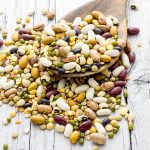
Finding proteins to replace egg in baking has been especially troublesome for vegans and vegetarians in the past but not anymore. For the product developer, finding a suitable substitute that offers the same functional properties of egg has been quite a challenge. Now it seems pulse flours are on the market and have come to the rescue by providing nearly as good solutions.
One feature of pulse flours is that they can come from non-GMO, low allergenicity , no cholesterol and from sustainable sources with the added bonus of course being gluten-free. Their main functional properties in food applications have been examined before but briefly these are moisture retention, water and fat binding, emulsion stabilization and thickening. They also have the potential for being gum replacers too as well as directly replacing eggs or gluten.
Eggs have and always will be popular baking ingredients because of these properties:-
– excellent solubility,
– emulsification,
– foaming,
– aeration
– gelation.
Eggs contain approximately 6%w/w protein which is substantial. The main proteins, are globulins (12%w/w) and albumins (71%). Pulses, in comparison, contain about 23%w/w protein with globulins (50-80%w/w) and albumins (15-25%). The differences are just enough to allow a degree of replacement for eggs especially where certain functions are needed in a food. We also find the differences between the vitamins and minerals to be a little challenging some times but each has its own merits.
Gluten has the ability to produce a great texture with excellent binding and confers moistness to a baked product. When we looked at gluten replacement especially in bars and powdered cake mixes or granola, we find that there are some pulses that really perform well. We have looked at some pea flours in baking especially which are lysine rich because we wanted to generate a browning effect similar to other flours in baking
Navy bean flour can be used with caution in baking muffins, cupcakes and cookies. Overuse leads to an unpalatable hardness. I’m told it works like whipped egg and has been tried in meringues. In macaroons, navy bean flour has helped replace both eggs and flour making them allergen-friendly but that application needs working on in the kitchen. Yellow pea flour looks good for the money. It offers reasonable fibre content as well as protein and seems to work well in beverages (I wont disclose the ideal amounts for commercial reasons but you can always call us !) Perhaps one of the best pulses we’ve noticed is the use of chickpea flour which performs slightly better than flaxseed flour although we wouldn’t dismiss the latter in our application exercises. Chickpea flour is readily available in health food shops, and some ethnic grocers if the home baker is keen to try it. It seems ideal in baking but don’t use it under other circumstances as it tastes unpleasant.
When we come to binders then lentil and split pea flours offer some special qualities. They seem to help in creating a good crumb. We’ve tried it as a batter binder with some small success. At least these are allergen-friendly. The yields are comparable to wheat- and soy-based crumb products. The proteins in the pulse flours provide the emulsification and binding properties traditionally provided by eggs. Another advantage is that no pre-hydration is required, so it is a one-step process.
The other benefits of pulses compared to eggs is that they store longer – about 2 years. They can be stored readily in containers without chilling, are compact and easy to use in applications. For those of you in the USA, when the flours are milled in North America that are regarded as ‘natural’ by various bodies such as the CFIA, FDA and USDA FSIS. Pulse flours are also currently an eighth of the price of eggs at the moment and less prone to the vagaries of price volatility.
If you are interested FoodWrite has developed various products over the years using pea proteins as a feasible replacement. Give us a ring or contact us via our web-site to discuss you requirements.

Have you tried chickpea flour – it is really useful in savoury dishes. I noticed on another post of yours that you talk a lot about chickpeas and I think they not only make excellent stews but the flour is also fantastic for soup and gravy. Not much added taste either !
I don’t think there is any replacement for the real thing. Ian Jones who chairs the British Lion egg industry also says the same. Egg replacers in whatever form have never taken off to any extent because of their cost and they are not versatile enough. I do not know if the alternatives are a serious challenge but I would not be complacent. By the way I’m an egg producer ! There are a number of businesses thinking they can produce egg-free alternatives which threaten the egg industry. I just think it wont happen. How you can you call something mayonnaise if it doesn’t contain eggs. This really annoys me because it is misleading the consumer.